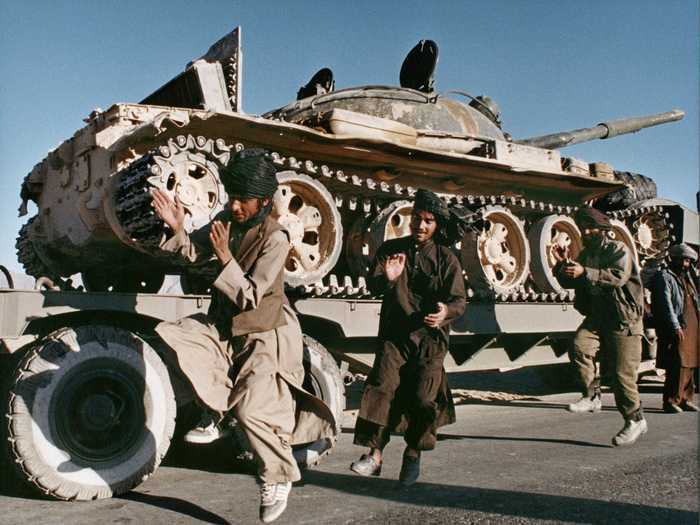
Three Taliban militiamen dance alongside one of their tanks at a position some 15 kms north of Kabul Saturday November 9, 1996 on their way to the front line.AP Photo/Santiago Lyon
Photos from Afghanistan's capitol city Kabul on Sunday illustrated chaos and disbelief amid the Taliban's swift takeover of the war-wrought country following the withdrawl of US forces and the collapse of the US-backed Afghani government.
But the striking scenes of men with machine guns and fleeing crowds are hardly unprecedented.
As Afghans wait to see what life will be like under the new regime, the country's past offers alarming indications of what the future may hold.
WARNING: Some photos contain graphic content.

The group had played a role in ousting the Soviets a decade earlier.
And by 1994, the Taliban had captured several provinces in the south from armed groups involved in the civil war that followed the collapse of the Soviet-backed Afghan government in 1992.

The group established the Islamic Emirate of Afghanistan — a name leaders of today's Taliban said the country would revert to following Sunday's takeover.
Fighters tortured and killed the former president, Mohammad Najibullah, before hanging his body from a traffic post in the streets.

The Taliban employed "morality police" from an agency called the Promotion of Virtue and Elimination of Vice.
Afghan people, in particular, women and religious minorities, faced unforgiving policies and practices under Taliban rule.

The Taliban closed schools for girls, and unaccompanied women risked being beaten in public.



Osama bin Laden gave media interviews from his compound in Afghanistan starting in 1998, and helped rebuild Taliban leader Mohammad Omar's new palace after a bomb blast destroyed it.

The group persisted in the country, reforming as a shadow insurgency dedicated to opposing the US-backed government in Kabul.

 2 states where home prices are falling because there are too many houses and not enough buyers
2 states where home prices are falling because there are too many houses and not enough buyers US buys 81 Soviet-era combat aircraft from Russia's ally costing on average less than $20,000 each, report says
US buys 81 Soviet-era combat aircraft from Russia's ally costing on average less than $20,000 each, report says A couple accidentally shipped their cat in an Amazon return package. It arrived safely 6 days later, hundreds of miles away.
A couple accidentally shipped their cat in an Amazon return package. It arrived safely 6 days later, hundreds of miles away. 9 health benefits of drinking sugarcane juice in summer
9 health benefits of drinking sugarcane juice in summer
 10 benefits of incorporating almond oil into your daily diet
10 benefits of incorporating almond oil into your daily diet
 From heart health to detoxification: 10 reasons to eat beetroot
From heart health to detoxification: 10 reasons to eat beetroot

Copyright © 2024. Times Internet Limited. All rights reserved.For reprint rights. Times Syndication Service.